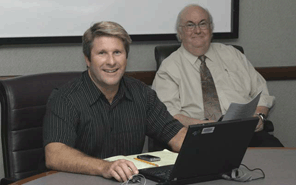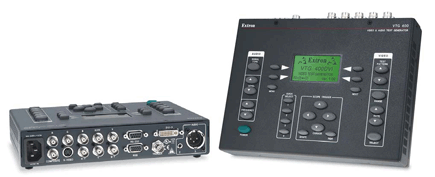Video Test And Measurement Solutions For A Digital Age
The pressure is on. The U.S. broadcast industry continues to invest in converting its facilities and workflows to high-definition. Meanwhile, new technologies continue to be introduced and external factors like FCC requirements present a veritable chess match for broadcasters. What’s the next move? How can contractors maintain signal fidelity or assess the quality of file-based video and HD versions of traditional programs? What technologies and techniques help test the
Extron’s VTG 400DVI video and audio test generator for offers DVI output for use with digital display devices in addition to support for analog high resolution computer-video, component video, S-video, and composite video. evermoving moving image?
Eben Jenkins, video test director, Tektronix, said that the pressure to deliver high quality video continues to mount for broadcasters and content producers alike. Whether to meet consumer quality expectations or to minimize errors or service interruptions, people are watching. Luckily, Tektronix’s waveform monitors are a reliable solution. “Aggressive, continuous enhancements ensure our waveform monitors provide the industry’s most robust video monitoring capabilities, such as 3Gb/s SDI support introduced last year,” Jenkins said. “Now, we are following up with additional enhancements to offer customers even more efficient quality monitoring and problem resolution.”
Richard Duvall, video marketing manager, Tektronix, noticed an important trend in storing and manipulating file-based AV, which “provides tremendous speed, flexibility, and cost savings, and has revolutionized content delivery in many ways.” As the alphabet soup of acronym files and formats in various states of compression clog up operations centers, Duvall sees quality control taking center stage: “Whether for broadcast or content on-demand audiences, the need to optimize the quality control process of file-based video content has become a critical requirement.”
An increasingly popular alternative to the error-prone manual process of visually inspecting video content is an automated system for conducting a thorough check of video files, like Tektronix’ Cerify system, which Duvall said will check all aspects of content—compliance/correctness to video and audio standards, video formats, resolutions, bit rates, adherence to transmission limits— and much more.
Extron Electronics also sees the increased need to calibrate and troubleshoot increasingly complex video systems, in just about every sector. That’s why the company’s designed the VTG 400DVI. The new VTG (Video and Audio Test Generator) tacks on the DVI suffix so contractors can use with digital displays to deliver full bandwidth video signal reproduction and high performance audio test signals. When used with DVI devices, the VTG 400DVI will display the native resolution whenever new EDID data is received. While digital is de rigeur, analog is still a reality, so Extron made sure that analog high-resolution computer-video, component video, S-video, and composite video are also supported.
Jeff Murray, sales and marketing manager with Sencore, has noticed how quickly HDMI is being tapped for extended distribution AV systems in the commercial market. Sencore answered this need by developing a brand-new tool, the Multi-media MP500.

Last May, Alan Brawn (right) led an ISF-C class at Texas Instruments/DLP, where Dan Smith (left), national sales director, Magenta Research, received his ISF-C certification. resolution component and RGB video inputs along with SPDIF and TOS-Link audio inputs can also be tested.
At InfoComm, Sencore will also demonstrate its new color analysis software used in tandem with color meters for color matching and light output in video displays, video walls, and digital cinema-type applications.
The ISF (Imaging Science Foundation) Commercial Certification, which will be offered InfoComm again this year, is another tool in the toolbox when it comes to image quality control. The two-day ISF Commercial Calibration and Certification Course covers the basics of signals, compression, and scaling, and culminates in an advanced analysis of each display type and technology. From 35mm film to LCoS, students will learn the critical methodology to evaluate and calibrate displays for the best performance.
Alan C. Brawn, CTS (ISF, ISF-C, DSCE) of Brawn Consulting in Vista, CA, is teaching the ISF class again this year and said that the value of certification is easy to qualify. And quantify. For an integrator, ISF helps offer clients the best experience that is closer to what the source creator intended. From digital signage applications to residential plasmas, calibration: “Sets the display up to standard,” Brawn said.
“Everyone makes good products,” he continued, “the difference is in how they are set up and calibrated.”
This clear differentiation in service makes economic sense, too. It helps builds relationships and continuity, and “Keeps the integrator connected with the client,” Brawn said. In other words, calibration can distinguish your firm and contribute to a recurring revenue stream.
No matter what the video source is, Brawn added that the cherry on top with proper calibration is the superior experience for end-users. There’s also the extended display life (up to 20 percent) and dramatically reduced power usage.











